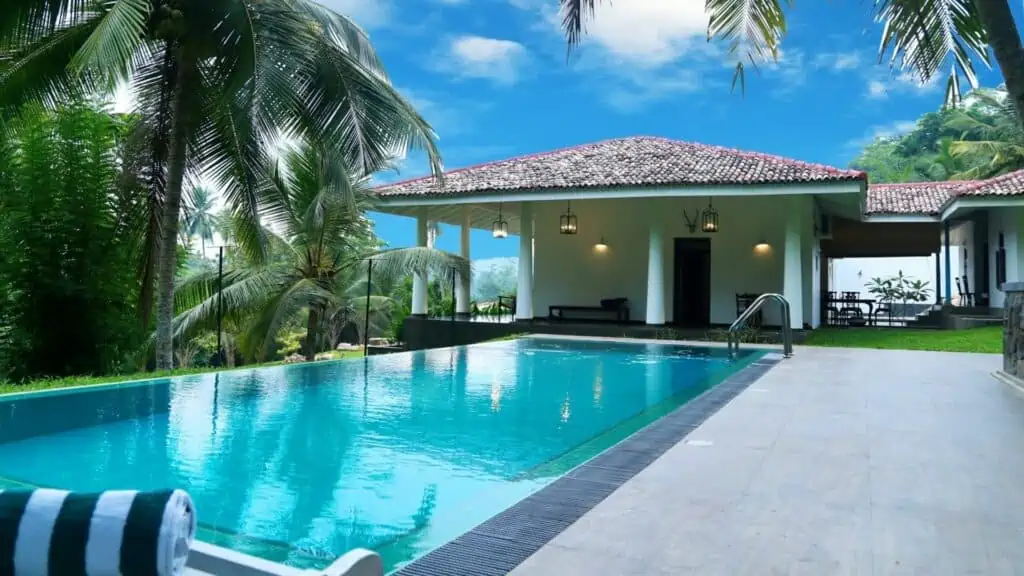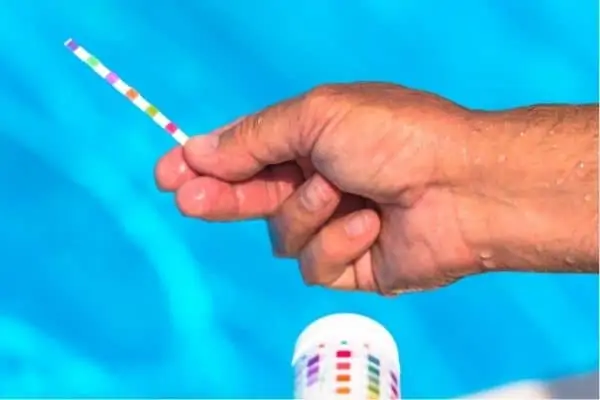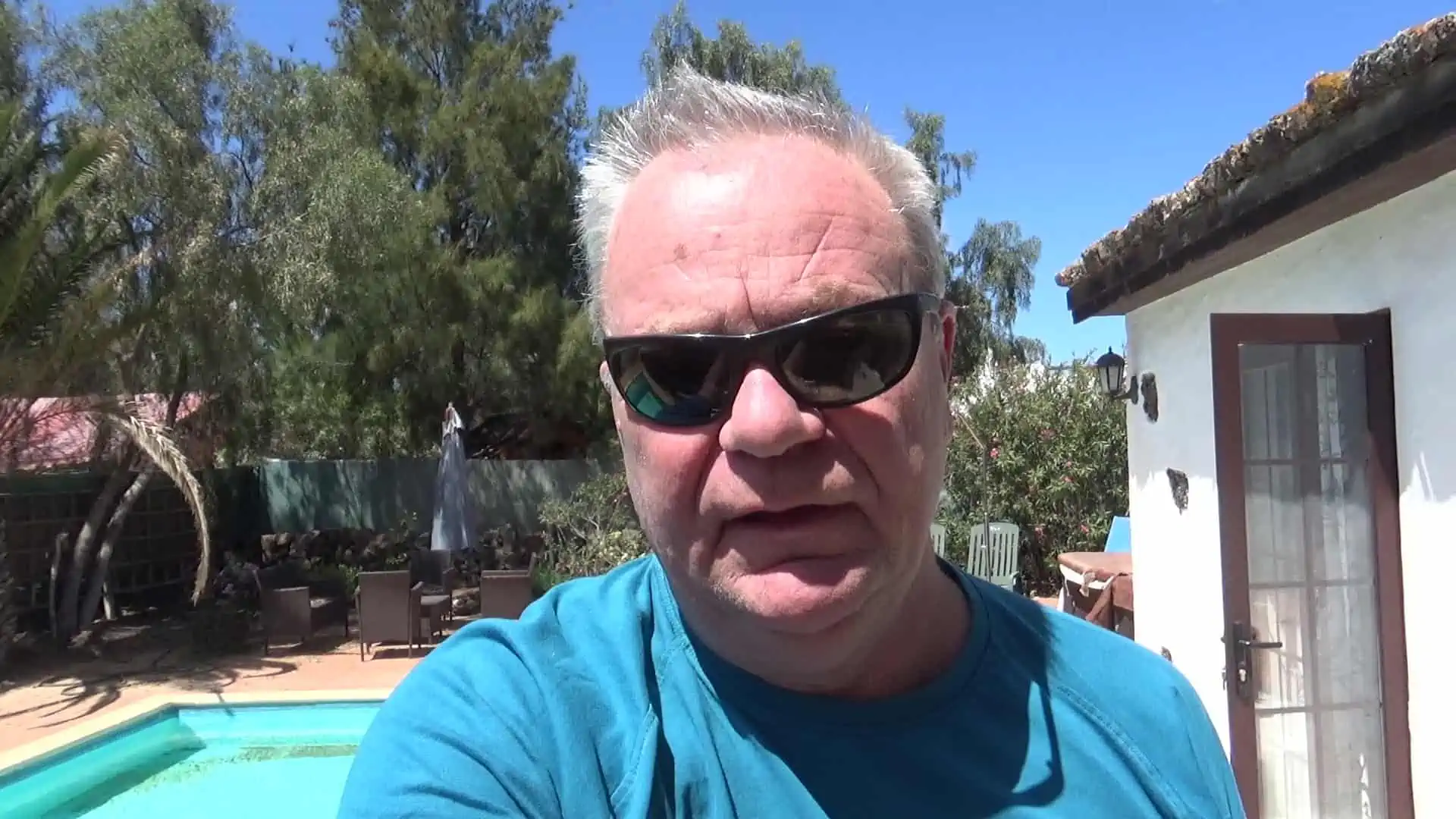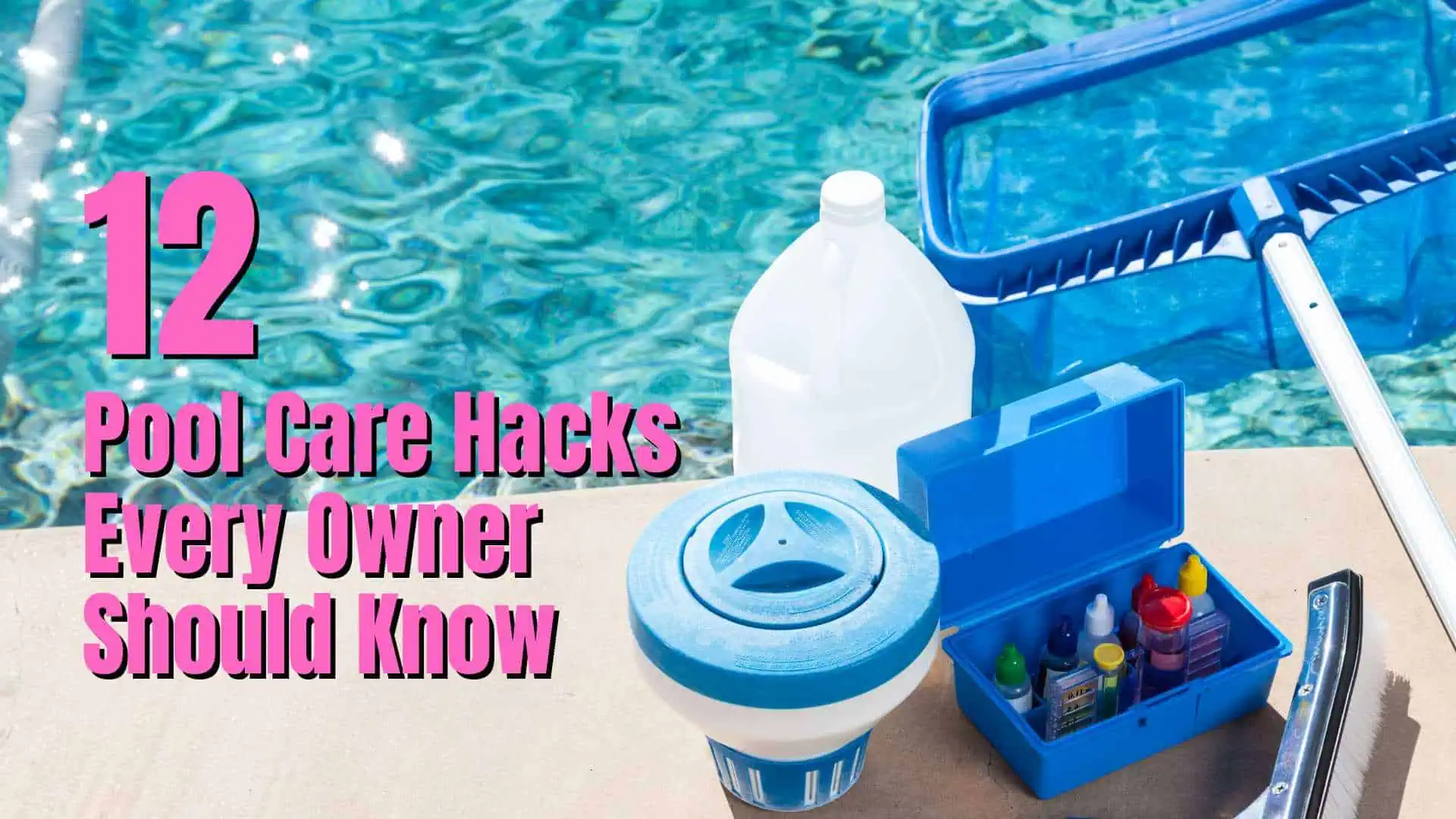A pool conditioner or stabilizer is a chemical used to protect your pool’s chlorine from the sun’s UV rays, which makes chlorine evaporate. Adding the right amount at the right time will save a lot of time and effort in purchasing more chlorine.
You will need to test your pool’s water chemistry and cyanuric acid levels to figure out how much stabilizer you need. Once you know the amount, add the pool stabilizer to a bucket of fresh, warm water and wait for it to dissolve. Then empty the bucket into your pool, ideally walking around the pool as you do so it is more evenly distributed.
This article will explain each step of this process in detail and discuss a few topics related to adding a stabilizer to a pool.
For instance, there are different ways to test your pool’s CYA levels, when you should add the stabilizer, and how chlorine stabilizers work. So keep reading.


Adding Cyanuric Acid To Pool: Cyanuric acid is commonly used in pools as a stabilizer for chlorine. Adding cyanuric acid to your pool protects the chlorine from being broken down by the sun’s ultraviolet rays, reducing the need for frequent chlorine replenishment. However, it’s important to maintain proper cyanuric acid levels to avoid over-stabilization, which can be detrimental to pool water balance.
What is pool stabilizer?
The stabilizer used in a swimming pool is cyanuric acid, also known as CYA.
Basically, cyanuric acid slows down the evaporation of chlorine from the pool’s water, which takes place due to the ultraviolet rays of the sun – in other words, it stabilizes the chlorine and gives i longer to work on the pool water.
Using cyanuric acid as a stabilizer is particularly important; therefore, if your pool is in full sun most of the day and is not covered with a solar pool cover, the chlorine levels will quickly drop. An indoor pool does not need a pool stabilizer as the sun cannot affect it.
How often do you put stabilizer in a pool?
When to add stabilizer to pool? Generally, you will only need to add stabilizer to your pool once a year. Pool stabilizer levels won’t decrease during this period as the acid is not used. This longevity means you don’t need to spend much time and effort maintaining its levels in your pool.
Even so, it would be best if you kept an eye on your pool’s cyanuric acid levels from time to time. Every month or so, do a home test or have a professional test to ensure the acid levels aren’t too high or low.
You should consider adding stabilizer if the level drops below 30 ppm (parts per million).
How much stabilizer to add to pool
Before you can start adding chemicals to your pool, you need to know how much you need.
The appropriate amount of stabilizer for your pool depends on its cyanuric acid (CYA) level. You can figure it out using an at-home liquid kit (see below) or by taking a water sample from your pool to a local pool store.
The cyanuric acid package will give you the manufacturer’s instructions for how much cyanuric acid you need to add to your size pool to bring the levels up.
I use In The Swim Pool Chlorine Stabilizer, which you can buy on Amazon.
The problem with adding too much stabilizer
If you add too much stabilizer, you will reduce the effectiveness of sanitizing. Instead of stabilizing your pool to an ideal level, it will stop the chlorine from doing its job completely.
This phenomenon is called a chlorine lock, and it basically means the chlorine stabilizer is doing the exact opposite of what it is supposed to do.
Once you add too much chlorine stabilizer to a swimming pool, the only way to reduce it is by removing some pool water and adding more fresh water. Not only is this a long and expensive process, but it is also completely unnecessary.
You can avoid it by doing the correct homework and only adding as much chlorine stabilizer as is necessary.

Pool stabilizer test kits
Ideally, you should be testing your swimming pool every week. Weekly tests are essential if you use it regularly and want to maintain its chemical levels.
However, going to a pool store every week isn’t very practical, so we’ve compiled a list of some of the best at-home test strips that you can use to keep an eye on the cyanuric acid level in your pool water.
Blue Devil CYA test kit
This kit has enough chemicals in it to do at least 6 to 8 tests on your pool. It is extremely accurate and will give you a clear picture of the chemical levels in your pool.
Blue Devil Cyanuric Acid Test Kit comes with a testing vial and easy-to-follow instructions. Figuring out your pool’s CYA levels won’t take more than 3 minutes with it.
Here’s how you can use it:
- Fill the test stick with water up until the line marked ‘A.’
- Add the solution provided until the line marked ‘B.’
- Mix the solution and let it sit for 3 to 4 minutes
- Look through the solution from the top and try to see the black dot. If you can’t see it, raise the stick above water level until it appears.
- Read the number value on the stick that is closest to the water level. This is your pool water’s CYA reading.
Pentair CYA test kit
Pentair Cyanuric Acid Test Kit is another effective at-home test kit. You can use it for around ten tests with the same method as the Blue Devil kit.
You add pool water to the solution provided in the product. Then, move the test tube until you can see the black dot. Once you see it, make a note of the number closest to the surface. This is your pool water’s CYA reading.
Test strips
A good test strip will not only tell you how much chlorine is in your pool and the pH of the water but will give other pool chemistry readings too.
I use AquaChek 7-Way Pool Water Test Strips, including tests for the CYA stabilizer level, free chlorine level, total chlorine, pH, alkalinity, hardness and bromine level.
Recommended Test Strips
How to add pool stabilizer
A stabilizer for pools is an acid that dissolves slowly. It is extremely corrosive as well. Manufacturers often recommend that people add it directly to swimming pool water as it eventually breaks down and dissolves into the water.
However, I believe that adding stabilizer to pool water directly is a bad idea as it can sit on the bottom of the pool and damage the liner.
So make sure you follow the advice below about how to add cyanuric acid to pool.
How to dissolve pool stabilizer
Irrespective of the manufacturer’s instructions, you should add a stabilizer by dissolving it into a bucket of warm water separately and then slowly adding stabilizer to the pool by pouring the diluted solution around the edge of your pool.
Liquid stabilizer dissolves more quickly than powder or stabilizer granules. This makes it easier to use. So, pick liquid stabilizer if you have an option between these three types.
Why not add it directly?

If you add the cyanuric acid directly to your pool, then with the possible high concentration, you could risk damaging everything it comes into contact with. This includes everything from your skimmer to the delicate components of your pool filter and even the surface of your swimming pool.
Each of these parts is super expensive and will need to be replaced if damaged even a little bit by undiluted acid. On the other hand, diluting the stabilizer by dissolving it in water reduces its strength and makes it non-harmful.
How to add chlorine stabilizer to above ground pool
In maintaining an above ground pool, one essential step is to add chlorine stabilizer to the water. Chlorine stabilizer, also known as cyanuric acid, plays a crucial role in preventing chlorine degradation caused by sun UV rays.
To add chlorine stabilizer to an above ground pool, follow these steps.
- Firstly, ensure the pool water is properly balanced, with a pH between 7.2 and 7.6.
- Next, determine the appropriate amount of chlorine stabilizer based on the pool size, as the product’s instructions recommended. Generally, for every 10,000 gallons of water, about 1.4 pounds of stabilizer is required.
- Once the correct amount is determined, pour the stabilizer into a bucket of water and stir until dissolved completely.
- Lastly, with the pool pump running, slowly pour the dissolved stabilizer mixture into the pool water near the skimmer or return jet. This allows for proper distribution and circulation of the stabilizer throughout the pool.
Regularly monitoring and adjusting the chlorine stabilizer levels in the above ground pool is essential for maintaining optimal water quality and ensuring effective disinfection.
How soon can you swim after adding stabilizer?
After adding stabilizer (often referred to as cyanuric acid) to your swimming pool, it is often recommended to wait at least 24 hours before swimming. However, I believe that is not necessary.
You should certainly run the pool pump after adding the CYA to allow it to mix thoroughly throughout the pool. This allows the stabilizer to fully dissolve and circulate throughout the pool, ensuring even distribution and effectiveness.
For this reason, it is probably better to add the stabilizer in the evening and run the pump overnight, so it will probably be ok to swim the following morning. However, you should always test the pool water before swimming to ensure that the CYA levels are not too high.
Pool Care Handbook and Video Course
When I bought my house with a swimming pool, I knew absolutely nothing about pool care. I just winged it for a while, making many mistakes along the way.
Fortunately, I was recommended Swim University’s Pool Care Handbook and Video Course. I bought it and it was an absolute game-changer.
It was the best money I spent that year. I learned everything from basic cleaning to advanced troubleshooting. Swim University offers a no-quibble refund policy too so what do you have to lose?
Using stabilized chlorine instead of chlorine stabilizer
Stabilized chlorine is a product that combines both chlorine and stabilizer. So, instead of adding chlorine to your pool and stabilizing once a year, you’ll do both together at appropriate time intervals.
You’ll be adding a bit of stabilizer every time you add chlorine. Many people see stabilized chlorine as a way to kill two birds with one stone. After all, if you use this product, you don’t need to worry about adding any extra stabilizer.
However, if you choose to do this, you will need to do weekly or bi-monthly testing as the CYA levels can get too high.
Do all pools need a stabilizer?
Remember that the stabilizer’s only purpose is to stop the sun’s UV Rays from eating away your pool’s chlorine. So, it is reasonable to assume you only need to add stabilizer to pools that are exposed to the sun.
Adding a stabilizer to an indoor pool, for example, won’t benefit you in any way, and the same would be true for an outdoor pool that was almost constantly in the shade.
Also read: What does cyanuric acid do?
Can you shock your pool and add stabilizer at the same time?
You should add shock first and give it a chance to work before adding stabilizer.
Once the higher chlorine levels exist after shocking start to reduce to a more normal level, you can then add the stabilizer to protect the remaining chlorine from being used up by UV rays.
FAQs
Do chlorine pool stabilizers really work?
Chlorine stabilizers work for outdoor pools. If you’re using one, you don’t need to add an extra stabilizer, as you’ll be adding a little bit every time you add chlorine. It is an effective method to introduce both chemicals to your pool. The only reason chlorine stabilizers are met with hesitation is that they can easily cause a chlorine lock. So you have to do regular cyanuric acid testing.
What’s the best time to use pool stabilizers?
Use a pool stabilizer whenever your pool’s CYA levels start dropping. Do regular testing using home kits or take a bit of your pool’s water to a local pool store and ask them to run the test. The right levels are between 30 and 50 ppm. Add some stabilizer if your pool’s CYA levels are below 30 ppm.
What’s the best way to add a stabilizer to a pool?
As long as you aren’t adding an undiluted stabilizer directly to your pool, you can use whichever method seems easiest to you. You can add it to your pool directly or combine it with chlorine. If you want to add it directly, you can purchase some from a pool store, dissolve it in water, and add the solution to your pool. Invest in a chlorine stabilizer if you prefer adding it combined with chlorine. These are available in liquid form as well as in chlorine tablets.
How long after adding stabilizer can I swim?
Ideally, you should add the stabilizer and run the pool pump for a short while (20 minutes or so) before swimming to allow the stabilizer to disperse around the pool. You should test to ensure you have not added too much first.

I have had hot tubs for over 20 years and a pool for the last 10 years. I had to learn how to clean, maintain and fix them the hard way. Since then I have helped many friends and neighbors with their pools and now I want to share everything I have learned with you. About Me








